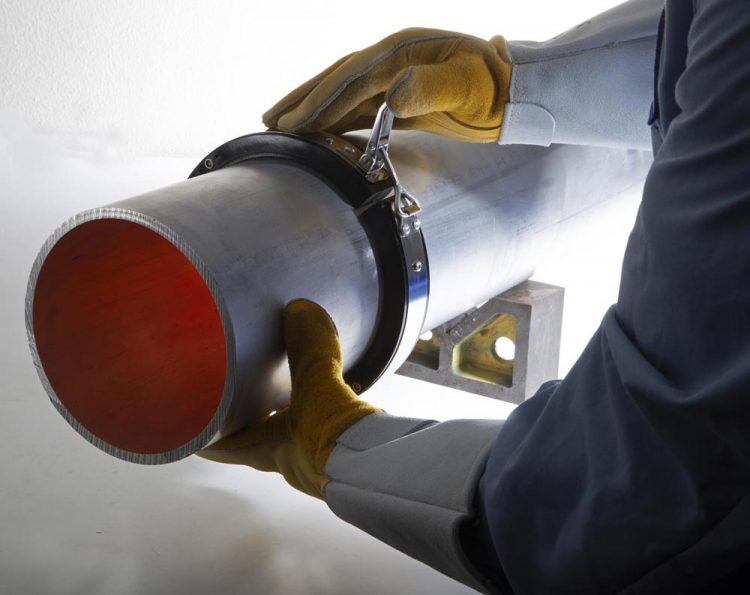SwRI improves structural health monitoring with magnetostrictive transducer

The user-friendly MsT sensor automatically adjusts frequencies to inspect structures, which reduces human error. At just 1.1 inches wide, MsT can squeeze into compact areas. The MsT can now scan a structure in segments, providing more precise and thorough inspections. Credit: Image Courtesy of Southwest Research Institute Usage Restrictions: Images/videos may be used by the media and the public for educational and informational purposes only.
A new, more powerful generation of a patented Southwest Research Institute magnetostrictive sensor withstands extreme temperatures, automatically adjusts frequencies and incorporates a stronger magnet. The compact magnetostrictive transducer (MsT™) more accurately detects potential problems in oil, gas and chemical industry metal and nonmetal structures such as pipelines, storage tanks and anchor rods.
“The MsT system offers the next level of signal strength. This user-friendly technology more precisely locates structural issues,” said Dr. Sergey Vinogradov, an SwRI staff engineer who led the initiative to improve the sensor. “It is an extremely reliable, state-of-the-art, durable sensor that you can install just about anywhere from subsea to open space.”
The circular, hard-shell MsT sensor clamps around pipes and other structures and is available in circumferences ranging from one-half inch to 70 inches. It detects material flaws, corrosion and areas at risk of developing cracks and leaks. At just 1.1 inches wide, MsT uses less shear-wave couplant, a gel that aids energy transmission, and requires less clamping force when dry coupled, meaning when no couplant is used.
The MsT sensor can be permanently installed on a structure to provide ongoing monitoring. A battery-operated hub collects and wirelessly transmits data from the sensor and can connect to multiple sensors at once. The hub can be programmed to change the sensors' frequencies automatically to meet industry safety standards, which require a structure be tested using at least two frequencies.
“The MsT is compact and easy to install, but it's also more convenient. With this improved sensor, the operator does not change hardware to change frequencies. And this function is automated, which reduces human error,” Vinogradov said. “This feature is especially useful when the sensors need to be installed at multiple, hard-to-access locations daily.”
High temperatures accelerate corrosion in metal structures. For that reason, MsT is designed to withstand up to 500 degrees Celsius (932 F). It can be installed on extremely hot structures to detect weaknesses and can also withstand temperatures significantly below freezing.
Additionally, the sensor can now scan a structure in segments, providing more thorough inspections. MsT has also made the time-consuming task of shifting from transversal to longitudinal guided waves easier with the flip of a built-in switch. Longitudinal waves are ideal for buried pipes, while transversal waves are better for inspecting structures filled with fluids.
This past spring, the American Society for Nondestructive Testing (ASNT) presented Vinogradov with the 2018 Research Recognition for Innovation Award for the MsT sensor. The award recognizes highly distinguished breakthroughs in nondestructive evaluation and testing research.
Vinogradov and his team are showcasing the MsT sensor at the ASNT Annual Meeting, October 28 – 30, 2018, at booth 932 at the George R. Brown Convention Center in Houston.
###
For more information on SwRI's nondestructive evaluation solutions, visit https:/
Media Contact
All latest news from the category: Medical Engineering
The development of medical equipment, products and technical procedures is characterized by high research and development costs in a variety of fields related to the study of human medicine.
innovations-report provides informative and stimulating reports and articles on topics ranging from imaging processes, cell and tissue techniques, optical techniques, implants, orthopedic aids, clinical and medical office equipment, dialysis systems and x-ray/radiation monitoring devices to endoscopy, ultrasound, surgical techniques, and dental materials.
Newest articles

Webb captures top of iconic horsehead nebula in unprecedented detail
NASA’s James Webb Space Telescope has captured the sharpest infrared images to date of a zoomed-in portion of one of the most distinctive objects in our skies, the Horsehead Nebula….

Cost-effective, high-capacity, and cyclable lithium-ion battery cathodes
Charge-recharge cycling of lithium-superrich iron oxide, a cost-effective and high-capacity cathode for new-generation lithium-ion batteries, can be greatly improved by doping with readily available mineral elements. The energy capacity and…

Novel genetic plant regeneration approach
…without the application of phytohormones. Researchers develop a novel plant regeneration approach by modulating the expression of genes that control plant cell differentiation. For ages now, plants have been the…





















